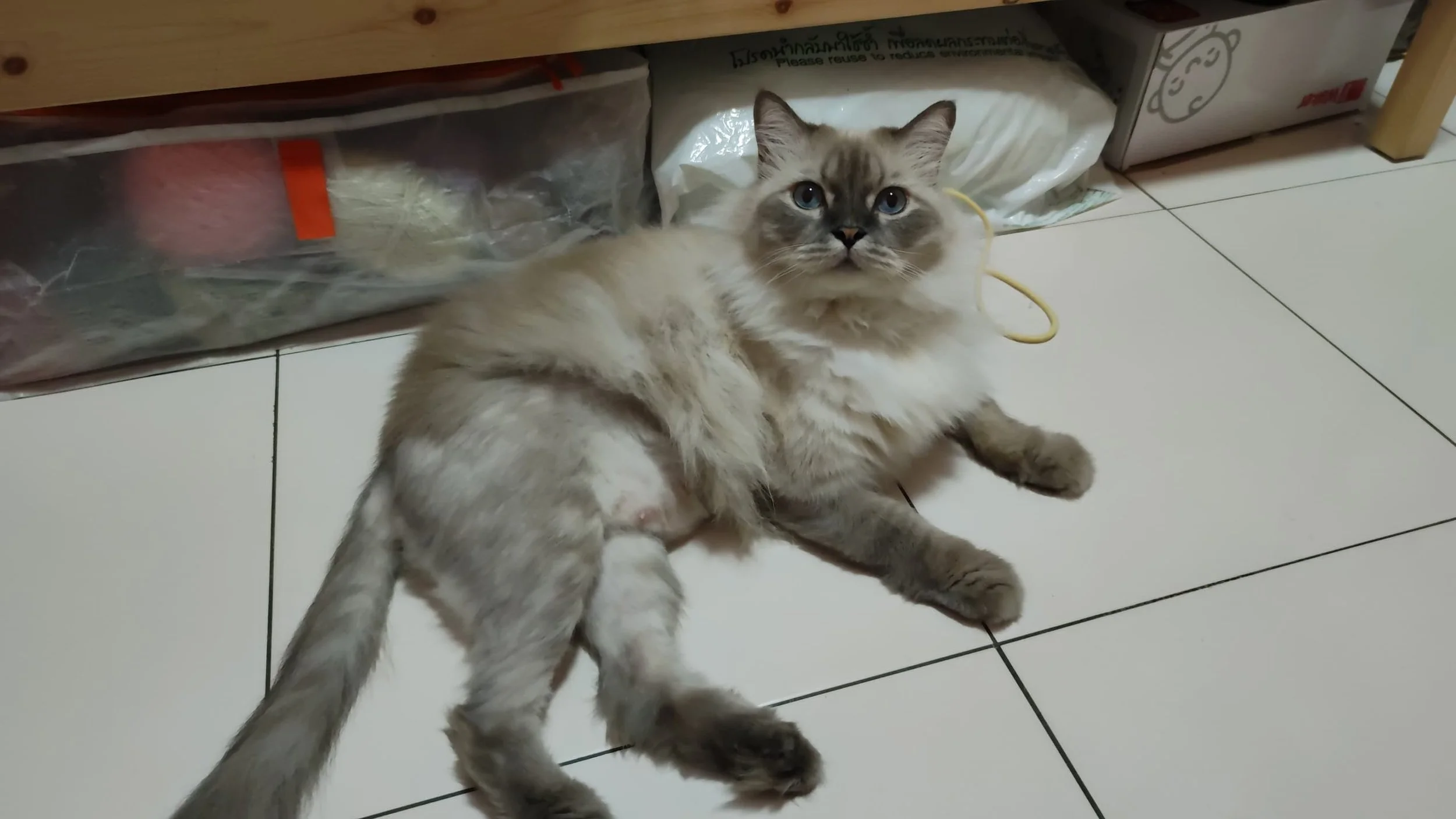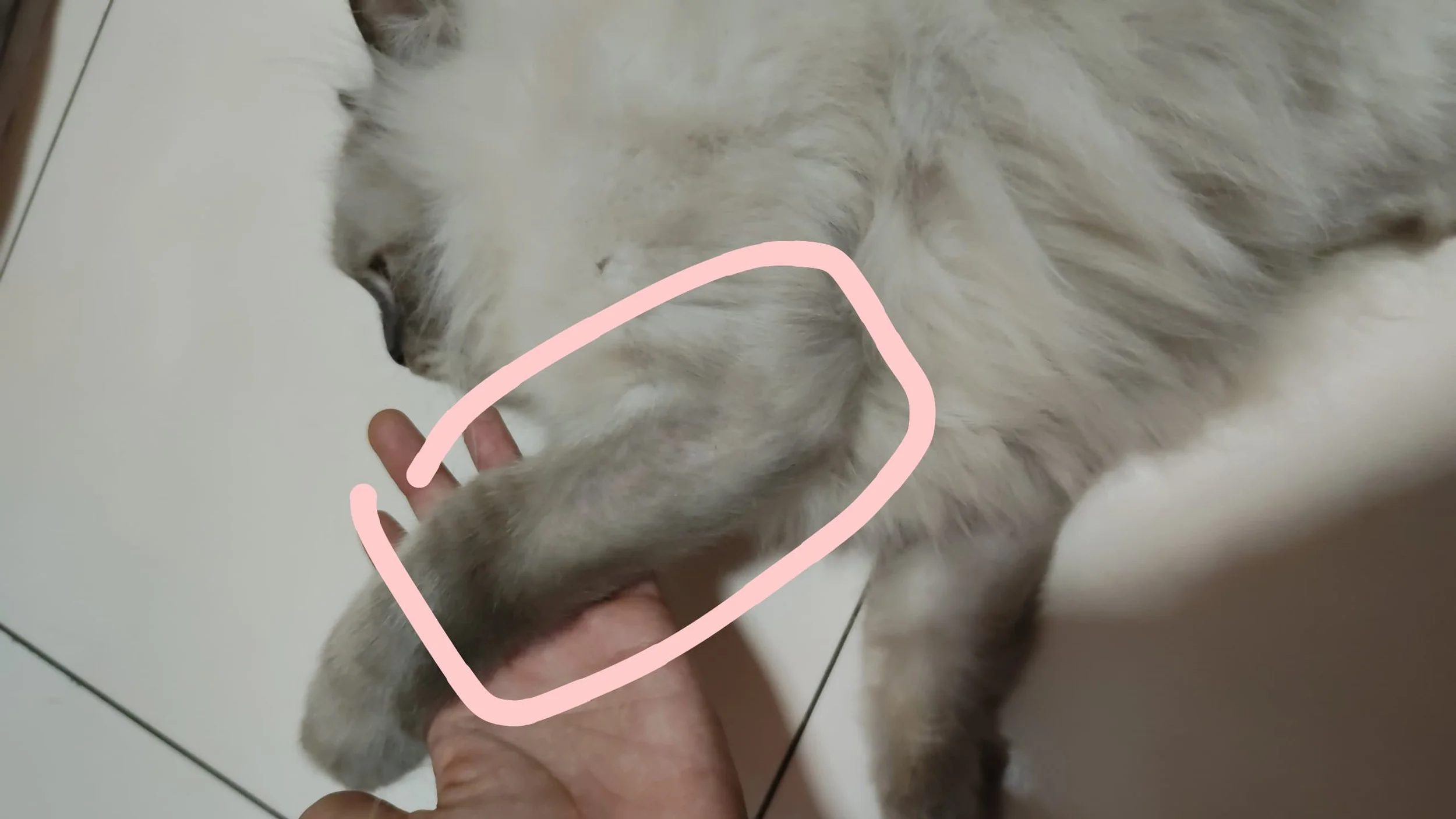🐾 Percy’s Progress: How Bioresonance Helped a Sensitive Soul Feel Safe Again
From stress signals to calm paws—an inside look at Percy’s journey through Bioresonance Therapy.
Meet Percy (Recap)
Percy isn’t your average cat—he’s expressive, affectionate, and not shy about showing his feelings. In recent years, Elise noticed him grooming excessively, especially around his back legs, which led to visible fur loss and bald patches.
From being a fluffy boy in 2022 to significant thinning by 2023–2025, it was clear this wasn’t just normal grooming. Something deeper was going on—and that’s what brought Percy to Furwave for his first Bioresonance check-up in April 2025.
2. What the First Check Up Showed (April 24, 2025)
Percy’s initial Bioresonance check up revealed several major imbalances that matched his symptoms of overgrooming and fur loss, especially around the hind legs and tail:
🔹 Psychogenic Stress:
Strong markers of depression, anxiety, and poor adaptation, suggesting that Percy’s grooming behavior was stress-driven (consistent with the arrival of new cats in the house).
🔹 Hormonal Disruption:
Imbalances in the hypothalamus, pituitary gland, and thyroid, with indicators of hypothyroidism—a likely contributor to coat thinning and low energy.
🔹 Allergies & Sensitivities:
Mild to moderate reactions to rabbit, turkey, goat, house dust mites, and hay-dust, all potential skin irritants.
🔹 Skin & Coat Health:
Disturbances in the skin glands and coat physiology, likely contributing to itchiness or discomfort.
🔹 Musculoskeletal Pain:
Signs of muscle tension, ligament inflammation, and spinal discomfort, which may have triggered Percy to focus his grooming on those areas.
🔹 Nutritional & Toxin Load:
Deficiencies in vitamins C, B1, and B2, along with traces of heavy metals (palladium, lead), which may have compromised skin health and stress tolerance.
To address these findings, Percy was placed on a customised Bioresonance therapy program designed to gradually harmonise and strengthen the affected systems. Alongside therapy, suggestions were provided for supportive care at home to further aid recovery.
3. The Treatment Timeline
| Date | Session Details |
|---|---|
| Apr 24 | First check up + short harmonisation |
| Apr 28 | First full RAH program |
| May wk 1 | Pawrents on trip; Percy continued on charged therapy water |
| May 13 | 2nd session |
| May 21 | 3rd session |
| May 28 | Check-up + 4th session with updated RAH program |
4. Real Behavioural Shifts
Right after the first session, something changed.
🔹 April 29: Percy allowed his bum to be washed calmly—normally a drama moment due to his strong aversion to water.
🔹 Became more chill—less excessive grooming, more lounging, and gentle exploring.
🔹 Willingly drank his therapy water for about a minute, showing clear engagement with his treatment.
🔹 Bolder and more confident—he now dares to go closer to the vacuum (previously he’d bolt into another room).
🔹 Playful again—Percy used to avoid playing with toys around the other cats, but now plays freely without hesitation.
5. Latest Scan (May 28) Results
A month later, major improvement!
Still showing heavy-to-moderate disturbances in:
Skin/coat and claws (R.+-)
Hormonal system (Hypothalamus R.N., Thyroid R.+-)
Mycosis & Thyroid Hypofunction
BUT—everything else stabilised or moved into OK range, including previously stressed organ systems and general physiology. 🎉
6. What This Means (In Simple Terms)
Percy’s body was overwhelmed—especially his hormonal and stress systems. Bioresonance therapy helped:
Rebalance his internal systems
Reduce stress sensitivity
Encourage natural healing
With continued sessions and home therapy (like charged water), Percy’s journey shows how even subtle shifts can bring peace to a reactive, sensitive pet.
7. Following Through at Home
While Percy’s therapy sessions play a role, his pawrents also played a big part in supporting his healing journey at home. Based on the care recommendations provided, here’s what Elise for Percy:
🐟 Adjusted Percy’s Diet:
By the 3rd session, his pawrents began transitioning him to a protein source that suited his sensitivities—no easy feat, as it took time and trial to find the right fit.
💊 Supplemented Nutrition:
She added vitamins, especially C, B1, and B2, to support his skin health and stress resilience.
🛡️ E-Collar Drama:
A soft e-collar was introduced to help break the grooming cycle. But Percy had other plans—while Elise was away, he took it off and hid it under the bed! 😹
(Not easy to locate after that, but effort noted!)
That said, Elise observed that Percy is still grooming more than usual, even with the collar—though now targeting other spots. This can sometimes happen during a detox phase, as the body releases toxins through the skin. In such cases, increased grooming may reflect the body’s natural way of responding to internal changes.
👇 Below are some photos showing mild fur thinning during healing—visual signs that Elise has been closely monitoring at home and updating us on, so we can address them in each follow-up session. Healing and adjusting care as needed.
Together, these efforts helped reinforce the effects of the bioresonance therapy—showing how meaningful healing comes from both bioresonance care and committed home support.
8. Final Thoughts
Percy’s case shows that Bioresonance isn’t just for “sick” pets—it’s for those who need support, balance, and calm in a world that sometimes overwhelms them. This therapy doesn’t force change; it gently nudges the body toward healing in a way that feels natural and respectful to the pet’s pace.
His journey is still ongoing, and we’re looking forward to continuing this healing path with Bioresonance—supporting Percy as he regains comfort in his skin, one gentle session at a time.
📩 Ready to Support Your Pet’s Healing Journey?
Book a Bioresonance Scan with us at Furwave and help your pet find balance, comfort, and calm—just like Percy. 🐾





